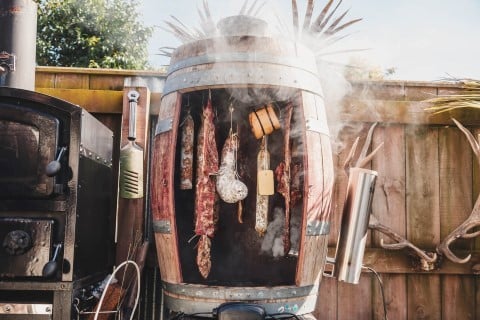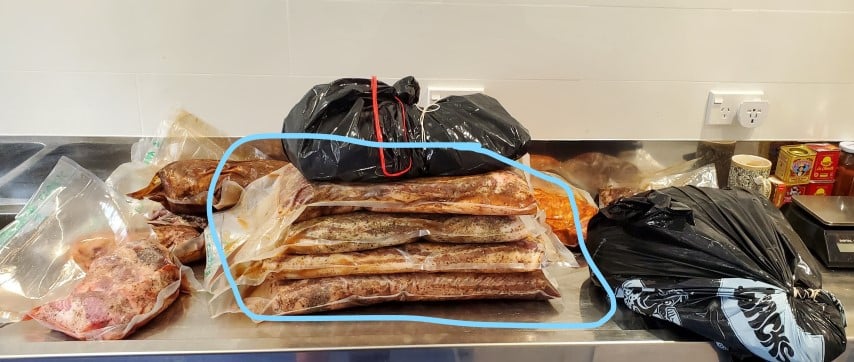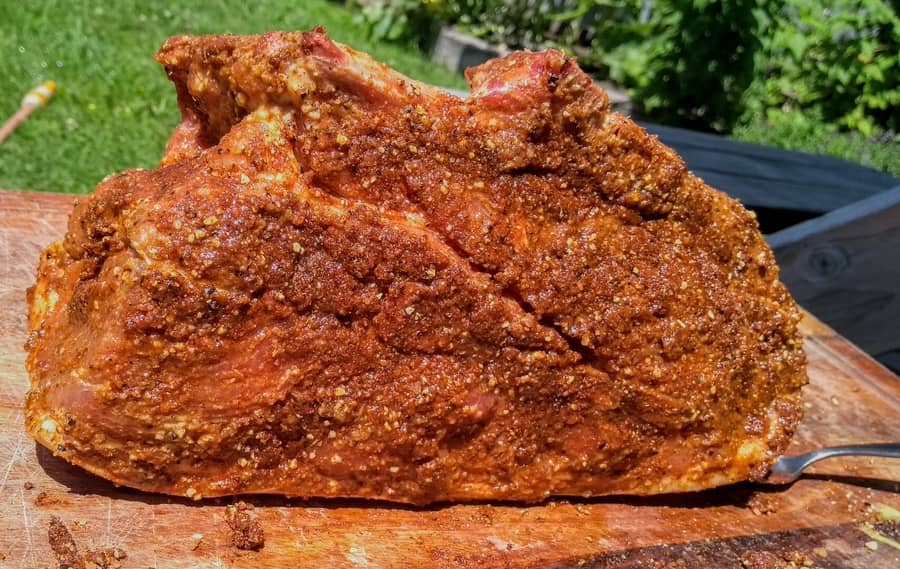When people hear the term cured meat, it often sparks confusion. Some think it means smoked, others believe it’s raw or unsafe to eat. Having cured and smoked meat for decades, I’ve learned that curing is a process all on its own — and it’s one of the oldest and most fascinating ways to preserve food.
This guide will explain exactly what cured meat means, how it’s made, and whether all smoked meat is actually cured. I’ll also share insights from my own curing and cold smoking setups, showing how salt, air, and time all work together to transform meat.

What Does “Cured Meat” Actually Mean?
At its core, curing means using salt to control moisture inside meat. By drawing water out of the muscle tissue, the environment becomes far less friendly to the bacteria that cause spoilage. It’s a natural preservation technique that predates refrigeration by thousands of years.
The process doesn’t necessarily cook or smoke the meat. Instead, it relies on chemistry — the salt binds to water molecules and slowly penetrates the meat. This reduces what’s known as water activity, slowing down bacterial growth and making the meat last far longer while developing richer flavor.
Depending on the recipe, curing can take anywhere from a single day for thin cuts to several months for large, whole muscles like ham or prosciutto. The longer the cure, the more complex and concentrated the flavor becomes.

The Role of Salt in Curing
Salt is the foundation of all curing. Whether it’s coarse sea salt, rock salt, or a blended curing mix, the principle is the same — it pulls out moisture, firms the texture, and seasons the meat. Salt also helps certain proteins bind, which improves the final texture when the meat is later sliced thin or cooked.
Over the years, I’ve found the key to consistency is measured salt application. Instead of guessing or using handfuls, I always weigh both the meat and the salt to achieve a balanced ratio. This ensures the curing process works evenly from edge to center, especially with larger cuts.
Different curing styles — dry curing, brining, or equilibrium curing — use salt in specific ratios to suit the meat and goal. Dry cures are rubbed directly onto the surface, while wet cures dissolve salt in water for immersion. Equilibrium curing is more precise and modern, using exact percentages of salt by weight.
Traditional vs Modern Curing Methods
Traditional curing relied purely on natural salt and time. Before refrigeration, people covered meat in thick layers of coarse salt, often mixed with sugar or spices. The salt would gradually draw moisture from the meat, hardening the outer layer and allowing it to dry safely in cool air.
Modern curing uses the same principles but with better control. By carefully weighing salt, temperature, and humidity, the results are more consistent and much safer. Modern approaches also use measured amounts of pink curing salt, which adds nitrates or nitrites for both flavor and protection against unwanted bacteria like Clostridium botulinum.
For anyone starting out, I’ve written a detailed breakdown of the main ingredients for curing meat — including how to balance salt, sugar, and optional curing salts for different projects.
While some traditionalists prefer all-natural salt-only cures, I often use equilibrium curing for predictable outcomes. It’s precise, repeatable, and ideal when dry-curing large cuts like pancetta, coppa, or bresaola. The method gives a beautiful balance between moisture control and flavor depth.
How Long Does Curing Take?
The curing timeline depends on meat type, thickness, and desired result. A small duck breast might take just a week, while a whole prosciutto can hang for a year or longer. During this time, salt diffuses slowly inward until the entire cut is stabilized and safe to dry or cold smoke.
In my experience, patience is everything. Rushing the process leads to uneven curing or an overly salty surface. Letting the cure penetrate fully gives the most consistent results — and a flavor that can’t be achieved any other way.
Why Meat Is Cured
Curing isn’t just about making meat last longer. It’s about transforming it. The salt, time, and controlled drying process change the structure of the meat at a molecular level, concentrating the flavor and improving its texture. The result is a product that’s safe, rich, and deeply satisfying to eat.
Preservation and Food Safety
Before refrigeration, curing was essential for survival. Salt preserved meat for months or even years, preventing spoilage in warm climates. Today, we use it more for flavor and tradition, but the same principles apply — controlling water activity and discouraging harmful microbes.
In modern food safety terms, salt curing reduces the environment bacteria need to thrive. Combined with drying or smoking, it provides a natural preservation system that’s stood the test of time. I always make sure meat is fully cured before introducing any smoke, especially in cold smoking where temperatures remain low.
Flavor Development and Texture
As meat cures, enzymes begin to break down proteins and fats, unlocking complex savory flavors. This is what gives prosciutto or pancetta that unmistakable depth — something that can’t be rushed or replicated with modern shortcuts. Texture also changes, becoming firmer yet more tender when sliced thinly.
I often describe the result as “seasoned time.” Every day in the curing chamber or fridge adds layers of flavor. The longer it hangs, the more character it develops, especially when combined with cold smoke for an additional aromatic touch.

My Experience Curing Different Meats
Over the years I’ve experimented with nearly every kind of meat — from venison to wild fish and pork. Each responds differently depending on the cut, fat content, and desired style. Lean meats like beef bresaola need precise humidity control, while fattier pork cuts handle longer curing and smoking beautifully.
Whether I’m hanging pancetta in a converted fridge or air-drying a small piece of salmon, the process always starts with salt. Once the cure has worked its way through, that’s when cold smoking adds the final touch of flavor and preservation.
Types of Cured Meat
There are many different styles of cured meat, each with its own purpose, flavor, and texture. The main distinction comes down to whether the cure is applied dry or wet. Some are further smoked after curing, while others are simply air-dried to perfection.
Dry-Cured Examples
Dry curing is the oldest form of preservation. Salt and spices are rubbed directly onto the surface of the meat, and the cut is left to rest for weeks or months. Classic examples include prosciutto, coppa, lonza, and bresaola. These are aged in a controlled environment with precise humidity until they reach a perfect balance of firmness and aroma.
Each region has its own traditions. In Italy, the process is elevated to an art form. In Spain, jamón serrano and jamón ibérico are cured for a year or more. In France, saucisson sec is fermented and aged with minimal ingredients. All rely on salt — nothing more — to preserve and intensify flavor.
Wet or Brine-Cured Examples
Wet curing, also known as brining, involves dissolving salt and other ingredients in water and immersing the meat in the solution. It’s commonly used for ham, corned beef, and traditional bacon. Brining allows for even salt penetration and helps maintain moisture when cooking.
Modern recipes often add small, measured amounts of pink curing salt for safety and color stability. However, it’s entirely possible to cure using only natural sea salt and time. I’ve discussed this further in my guide on curing without sodium nitrates or nitrites, where I explain when it’s appropriate and when you might want to use a curing salt for added protection.
Smoked Cured Examples
Some of the most loved cured meats are also smoked — like bacon, smoked salmon, and speck. After the salt curing stage, these meats are exposed to smoke from smoldering wood chips at low temperatures. The smoke adds antimicrobial compounds and layers of complex flavor.
Cold smoking, in particular, is done below 30°C (86°F) so that the meat doesn’t cook. It gently dries the outer surface, enhances aroma, and deepens the preservation effect. I’ve created a detailed guide to cold smoking covering temperatures, wood choices, and setup options for anyone wanting to explore this craft further.

Is All Smoked Meat Cured?
The short answer is no — not all smoked meat is cured. Many smoked foods, especially barbecue and low-and-slow styles, are cooked using smoke for flavor but never cured beforehand. These meats rely on cooking temperature to make them safe, not on salt preservation.
When we talk about curing and smoking together, we’re really describing two separate processes that sometimes overlap. The cure happens first, removing moisture and stabilizing the meat. Smoking comes later, either to cook it (hot smoking) or to further dry and flavor it (cold smoking).
Hot Smoking vs Cold Smoking
Hot smoking happens above 65°C (150°F) and cooks the meat as it smokes. This is what you see in barbecue — brisket, pulled pork, and ribs. These are delicious but perishable; they’re not cured products and must be eaten or refrigerated shortly after cooking.
Cold smoking, on the other hand, occurs at much lower temperatures, under 30°C (86°F). It doesn’t cook the meat but adds subtle flavor and drying over many hours. When paired with a salt cure, it creates traditional preserved foods like bacon, smoked ham, and cold-smoked salmon.
To understand how smoke interacts with cured meat, I’ll go into more detail in my next section on the science of how smoke preserves and enhances flavor.
Why Most Hot Smoked Foods Aren’t Cured
Barbecue styles like brisket, ribs, and pulled pork are hot-smoked and cooked to safe internal temperatures.
They’re seasoned, sometimes brined, but typically not salt-cured for preservation. Once cooked, they’re perishable and should be eaten promptly or refrigerated.
Think of it like an outdoor oven, at low temperature with smoke around it.
The ‘rub’ is more of a salt, sweetener, and spice coating – the sugar reacts to assist in forming ‘bark’ or a crust on certain projects.
Some hot smoking is about light salt curing/brining to hold moisture around the surface of the meat, which helps during cooking to keep it moist. ie. Brined Turkey, Hot Smoked Fish.
By contrast, a proper cure happens before any optional smoking. Salt penetrates the meat, reducing water activity throughout the cut. Only after that can cold smoking add gentle drying and aroma without cooking the meat.
Color & Aroma
Cured meats show a uniform color when sliced thin, with a clean, seasoned aroma (and sometimes a pink hue if nitrite was used). Hot-smoked meats often exhibit a surface smoke ring and cooked aromas, but lack the deep, even “cured” appearance throughout the center.
How Smoke Supports Preservation (After Curing)
Cold smoke contributes mild drying and introduces smoke compounds that can slow surface spoilage. It’s not a replacement for salt, but it complements a proper cure. If you want the deeper dive on this science, I’ve broken it down here: how smoking preserves meat and fish.
Helpful, Trusted Resources
For an official overview of safe curing practices, see the USDA guidelines on curing meats safely. For an approachable introduction to classic cured styles, this guide to cured meats and charcuterie is a solid primer.
Related Reading and Next Steps
If you’re comparing the two processes side-by-side, read my overview on the difference between cured and smoked meat. If you want to apply smoke after curing, start with my practical guide to cold smoking.
What is the purpose of curing meat?
Curing uses salt (and optionally nitrite/nitrate) to reduce water activity throughout the meat. This stabilizes the product against spoilage and creates the distinct flavor and texture we associate with prosciutto, bacon, and other classics.
Can you cure meat without salt?
No. Salt defines curing because it drives diffusion and moisture control. You can season or smoke without salt, but that is not curing. Pink curing salts (#1 or #2) are optional tools depending on the project length and style.
Is smoked meat safe if it isn’t cured?
Hot-smoked foods can be safe because they are cooked to food-safe temperatures, but they are perishable and must be handled like other cooked foods. Cold-smoked products should be properly cured first because cold smoke does not cook the meat.
Do I need pink curing salt (nitrite/nitrate)?
It depends on the project. For many short cures, people use sea salt only. Pink curing salt #1 is commonly used for shorter, cooked or hot-smoked projects; #2 is used for long dry cures. Their use is a personal preference and style choice.
Questions or experiences to share? Drop a comment below — I read every one and I’m happy to help.

Tom Mueller
For decades, immersed in studying, working, learning, and teaching the craft of meat curing, sharing the passion and showcasing the world of charcuterie and smoked meat. Read More
